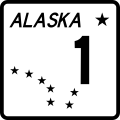    Shields used for Alaska Routes | |
| Highway names | |
|---|---|
| Interstates | Interstate A-n (A-n) (unsigned) |
| State | Alaska Route n (AK-n) or Route n |
| System links | |
Alaska Routes are both numbered and named. There have been only twelve state highway numbers issued (1 through 11 and 98), and the numbering often has no obvious pattern. For example, Alaska Route 4 (AK-4) runs north and south, whereas AK-2 runs largely east and west, but runs north and south passing through and to the north of Fairbanks. The Klondike Highway, built in 1978, was unnumbered until 1998, when it was given its designation during the centennial of the Klondike Gold Rush. However, many Alaskan highways of greater length than the Klondike Highway remain unnumbered.
Contents
- Highways
- U.S. Highways
- Alaska numbered highways
- Alaska named highways
- Marine Highway system
- Gallery
- See also
- References
- External links
Mileposts, frequently used for road markers and official addressing in rural areas, are also more commonly reckoned by landmark names.
Within Alaska, roads are almost invariably referred to by name or general destination, and not by number(s).[ citation needed ]
Numbered routes often span multiple highway names. For example, AK-1 can refer to any of the Glenn Highway, Seward Highway, Sterling Highway, or Tok Cut-Off; meanwhile, portions of the Seward Highway are numbered AK-1, AK-9 and Interstate A3 (A-3).










